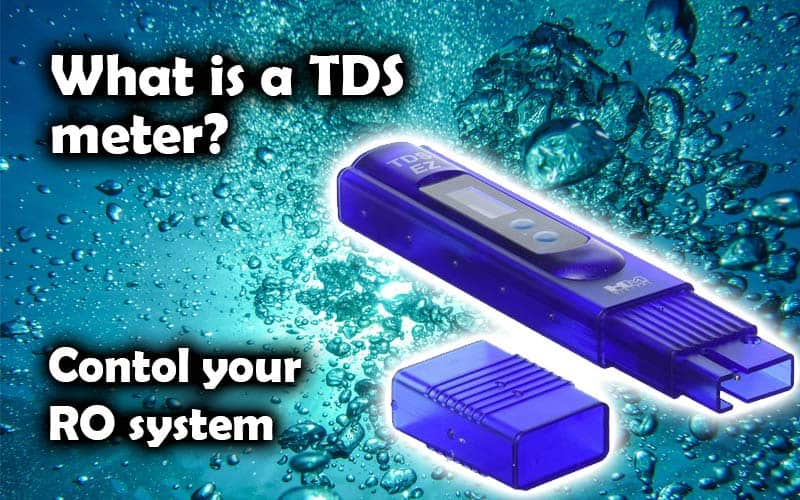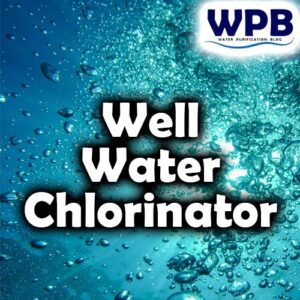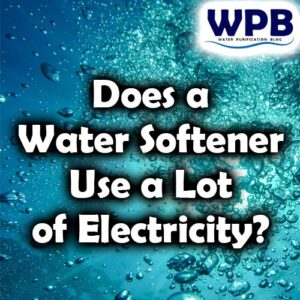What is TDS and What Is a TDS meter?
TDS meter is a great water treatment test and effectiveness test of reverse osmosis house filtration systems by measuring total dissolved solids in water.
It is the easiest way to measure total dissolved solids in your water and to control your drinking water quality after your RO water filter.
Table of Contents
What is a total dissolved solids value?
TDS stands for total dissolved solids in your water. This is a measurement of all dissolved substances in the water.
These “dissolved solids” are primarily inorganic salts such as the anions of chloride, bicarbonate, carbonate, phosphate, sulfate, and nitrate, as well as the cations of sodium, calcium, magnesium, and potassium.
Total dissolved solids value also includes dissolved organic compounds.
The unit of measurement is parts per million (ppm), which is equivalent to milligrams per liter (mg/l).
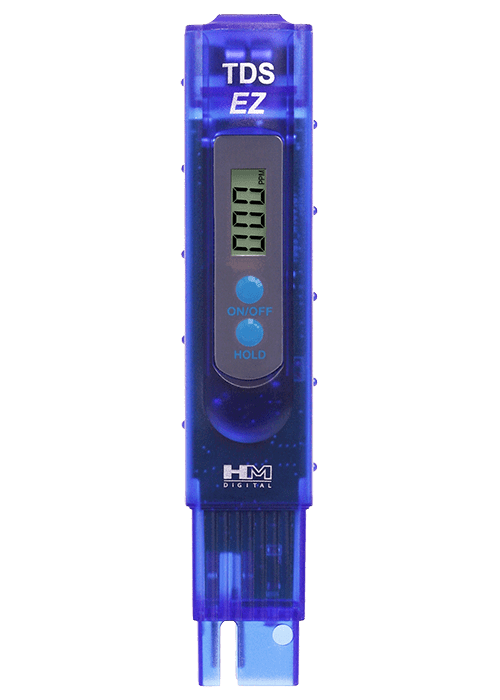
What is a TDS meter and how it works
The TDS meter does not directly measure total dissolved solids. A portable or handheld TDS meter measures electrical conductivity (EC). The unit of measurement for EC is microsiemens (µS).
The TDS meter converts EC to TDS as parts per million (ppm).
It is an essential part of of a water testing kit to get the complete picture about industrial, well or tap water quality.
What is TDS Value?
TDS is a simple measurement of all dissolved solids in your water. Distilled water has a TDS of several ppm, while seawater has a TDS of around 10,000 ppm. Both water sources are safe. Acceptable TDS is related to the water being tested and the purpose for which it is used.
Usual water filter will not change the TDS value of your drinking water. Only water filters with RO membranes can change and lower the TDS value.
Using a TDS meter
Using a TDS meter is very simple. It is the best to take a sample of the water you want to test in a clean glass.
When taking samples you should always let the tap water to flow for few seconds. Pour approximately half of the glass with water you want to test.
Take the TDS meter and turn it on and submerge it’s lower part, where the probe is, in the water.
Wait for the reading to stabilize and read the TDS value.
After reading the value turn off the TDS meter, if you have some distilled water pour it over the TDS meter probe.
What types of TDS meters are available?
There are several types of TDS meters available on the market, including handheld meters and in-line meters that can be integrated into water treatment systems.
Handheld TDS meters are small and portable, making them ideal for testing water samples in the field or at home.
In-line TDS meters, on the other hand, are typically used for continuous monitoring in industrial or commercial settings.
Where are TDS meters mostly used?
Total dissolved solids meters are used in a variety of industries and applications where water quality monitoring is important, including:
- Water quality testing: TDS meters are commonly used to test the quality of drinking water, surface water, and groundwater. They can be used to ensure that the water meets regulatory standards for dissolved solids, as well as to monitor changes in water quality over time. They are usually a part of a complete water testing kit.
- Water treatment and purification: TDS meters can be used to monitor the effectiveness of water treatment systems, such as RO systems and ion exchange systems, which remove dissolved solids from water.
- Agriculture: TDS meters can be used to measure the salinity of irrigation water, which can affect the growth and health of crops. High TDS values can show if you need a water filter.
- Industrial process control: total dissolved solids meters are commonly used in industrial processes, such as boiler feedwater, cooling water and other process water systems, to ensure that the water meets the required standards for dissolved solids.
- Aquariums: TDS meters are used by aquarists to measure the dissolved solids concentration in aquarium water, and to ensure that the water quality is within the proper range for the fish and other aquatic life in the tank.
- Coffee and tea brewing: TDS meters are used by coffee and tea professionals to measure the concentration of dissolved solids in the water used for brewing, as water quality can affect the taste and quality of the final product. TDS value can tell you if you need a water filter to improve the taste and even appearance of coffee and tea.
- Food and Beverage Processing: In the food and beverage processing industry, monitoring and controlling Total Dissolved Solids (TDS) levels in water is important to maintain the quality of the products. Many food and beverage processes use RO systems to reduce TDS levels, and use high quality purified water in different productions.
- Domestic use: if you want to be sure your reverse osmosis water filter is performing well you should know the total dissolved solids in your water. The tap water purified quality should be checked periodically with a TDS meter. This will prevent water filter problems and keep constant purified tap water water quality.
Some of the most popular RO systems are the Aquasana water filters. By regularly using a TDS meter, the necessary steps to ensure the safety and purity of purified drinking water can be taken on time. If you have a Aquasana water filters or any other type of RO water filter, you also need a TDS meter to check it’s operation. - Hydroponics: In hydroponics, a TDS meter is an essential tool for monitoring the Total Dissolved Solids (TDS) in water. TDS in hydroponics refers to the measurement of salt, nutrients, and other concentrates present in water and is measured in parts per million (PPM). Monitoring TDS is crucial for the success of hydroponic operations. A TDS meter measures the electrical conductivity of water in Siemens per meter and then converts it to TDS (in PPM) using a simple formula. The benefits of using a TDS meter in hydroponics include accurate measurements, affordability, and ease of use.
The best methods to reduce TDS in water
Reverse Osmosis: The Best Method to Reduce TDS
RO is considered the best way to reduce TDS in water. The process involves pushing water through a semi-permeable membrane to remove over 95% of dissolved solids, including heavy metals and harmful impurities.
RO is one of the most popular methods of removing TDS from water, providing you with pure and clean water to drink.
Other Reliable Methods to Reduce TDS
In addition to reverse osmosis, there are other reliable methods to reduce TDS in water. These include:
- Distillation: This method involves boiling water to turn it into steam and then collecting the steam, which has had the TDS removed.
- Nanofiltration: This is similar to reverse osmosis, but it uses a smaller pore size in the membrane, making it effective in removing smaller TDS particles.
Benefits of Reducing Tap Water TDS Levels
Adequate filtration can help to reduce the TDS level in water, making it better to drink and consume. The benefits of reducing TDS levels include:
- Reduced health risks: High levels of TDS in drinking water can cause various health problems. Reducing TDS levels can help to reduce the risk of these issues.
- Improved water quality: With reduced TDS levels, the water you drink will be of better quality and taste, providing you with a more enjoyable drinking experience.
What are the main parts of a TDS meter?
A TDS meter typically consists of a probe with two electrodes, which are inserted into the liquid being tested.
The electrodes measure the conductivity of the liquid, which is directly related to the concentration of dissolved solids. The meter then uses this measurement to calculate the TDS value.
TDS meter maintenance
Take care not to submerge the TDS meter completely in water. Submerge only the lower part where the probe in located.
A TDS meter has two metal probes and a small connector at the bottom of the meter. Do not damage or bend the probes.
Do not immerse the meter in substances that can coat and damage the probes. Paint, glue, food, and other sticky substances can damage the probes.
Do not immerse the TDS meter in hot liquid.
After using the TDS meter, rinse the probe with water, preferably distilled water. The goal is to flush all contaminants from the probe.
TDS meters accuracy
The use and the accuracy of TDS meters vary widely, so it is important to choose a quality instrument and to calibrate it properly before using.
And it is also important to note, TDS meters only measure dissolved solids, it does not measure other contaminants like bacteria, viruses, heavy metals and other impurities, therefore it is always better to use it in combination with other tests to get a comprehensive understanding of water quality.
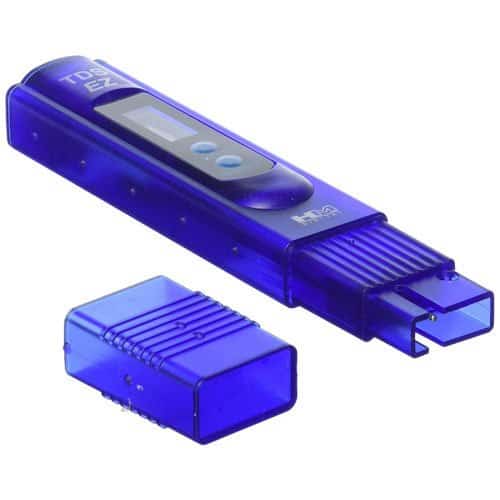
H&M Total Dissolved Solids / Conductivity Test Meter
This handy, portable meter is used by water quality professionals to test the effectiveness of your reverse osmosis filtration system.
Portable and handy TDS meter is a great water treatment test and effectiveness test of reverse osmosis house filtration systems. Advanced technology, easy use.
TDS meter features
- Advanced microprocessor technology
- Hold Function: saves measurements for record keeping
- Auto-off function: shuts off automatically after 10 minutes of non-use to save batteries
- Range: 0-9990 ppm. From 0-999 ppm, the resolution is in increments of 1ppm. From 1000 to 9990 ppm, the resolution is in increments of 10ppm, indicated by a flashing ‘x10’ icon
- LCD Display screen
- Factory Calibrated. Easily recalibrated with a mini-screwdriver
- Durable housing
- TDS values chart affixed to rear of meter
Frequently Asked Questions
- What is TDS?
Total Dissolved Solids (TDS) are the combined total of all inorganic and organic substances found in water. - What is the best way to reduce TDS in water?
Reverse Osmosis (RO) is considered the best way to reduce TDS in water. - Can high levels of TDS in drinking water cause health problems?
Yes, high tds meter reading in tap water can cause various health problems, such as stomach issues, headaches, and fatigue. - What are the other methods to reduce TDS in water?
Other methods to reduce high tds meter reading in water include distillation, ultrafiltration, and nanofiltration.
Conclusion
In summary, TDS meters are a simple and cost-effective way to measure the concentration of dissolved solids in water, but the measurement is only one aspect of water quality and should be considered alongside other measurements to get a comprehensive understanding of water quality.
It can be an indication if you need a water filter.
Proper calibration and usage of the meter will give accurate and reliable results for intended applications.

Who am I?
I am working as a water treatment technical manager and I have more than 25 years of practical experience in water purification.
Water purification expert
After many years of experience in water purification, I want to share some of my knowledge and get people to know the real importance of water quality.
Water purification and water treatment are very complex themes, so it is important to explain them in an easy-to-read way.
On this blog, you will find many understandable, easy-to-read information about water purification.
I hope you enjoy it, find some useful information, and thank You for reading.
More info on my work and my expertise on water purification can be found on my LinkedIn profile.

